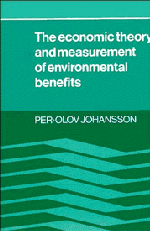Book contents
- Frontmatter
- Contents
- Preface
- 1 Introduction
- 2 Some basic concepts
- 3 The concept of consumer surplus
- 4 Topics in the theory of consumer surplus measures
- 5 Consumer surplus measures in quantity-constrained regimes
- 6 Public goods and externalities in consumption
- 7 How to overcome the problem of preference revelation; practical methodologies
- 8 Discrete choice models and environmental benefits
- 9 Consumer's surplus in an intertemporal context
- 10 Welfare change measures in a risky world
- 11 Money measures of the total value of environmental assets
- Notes
- Bibliography
- Index
9 - Consumer's surplus in an intertemporal context
Published online by Cambridge University Press: 10 January 2011
- Frontmatter
- Contents
- Preface
- 1 Introduction
- 2 Some basic concepts
- 3 The concept of consumer surplus
- 4 Topics in the theory of consumer surplus measures
- 5 Consumer surplus measures in quantity-constrained regimes
- 6 Public goods and externalities in consumption
- 7 How to overcome the problem of preference revelation; practical methodologies
- 8 Discrete choice models and environmental benefits
- 9 Consumer's surplus in an intertemporal context
- 10 Welfare change measures in a risky world
- 11 Money measures of the total value of environmental assets
- Notes
- Bibliography
- Index
Summary
Thus far we have dealt exclusively with consumer surplus measures in single-period models. This chapter opens a sequence of chapters that all deal with intertemporal problems. In developing the theory it is as well to discuss the simplest considerations first. For this reason the assumption that agents do not face any uncertainty is retained throughout the present chapter.
Section 1 extends the single-period model described in Chapter 3 to cover optimization for T-period horizons. Overall or lifetime consumer surplus measures are briefly discussed. Such overall measures, however, require huge amounts of information and may be difficult to calculate and estimate. Section 2, therefore, introduces so-called instantaneous consumer surplus measures, and investigates whether the present value of such instantaneous surpluses has the same sign as the lifetime utility change.
The prime attention in this book is focused on consumer surplus measures in atemporal and intertemporal models. However, in some applications, e.g. fishing and hunting, the size of the stock of a natural resource is of importance. Accordingly, the second part of this chapter focuses on models with renewable natural resources. In Section 3 the basic model developed in this chapter is modified so as to include a renewable resource. Section 4 presents a model used by Brown and Hammack (1972) and Hammack and Brown (1974) to analyse the optimal allocation of prairie wetlands in the north-central U.S. and Southern Canada.
- Type
- Chapter
- Information
- The Economic Theory and Measurement of Environmental Benefits , pp. 147 - 162Publisher: Cambridge University PressPrint publication year: 1987



